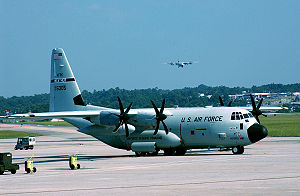Lockheed WC-130
From Wikipedia, the free encyclopedia
| WC-130 Hercules | |
|---|---|
|
|
|
| Role | Military transport aircraft |
| Manufacturer | Lockheed Lockheed Martin |
| Introduction | 1962 |
| Status | Active |
| Primary user | United States Air Force |
| Unit cost | Approximately US$48.5 million (FY 1998 constant dollars) |
| Developed from | C-130 Hercules C-130J Super Hercules |
The Lockheed WC-130 Hercules is a high-wing, medium-range aircraft used in weather reconnaissance missions. This plane is a C-130 transport configured with palletized weather instrumentation for penetration of tropical disturbances and storms, hurricanes and winter storms to obtain data on movement, size and intensity. The WC-130 is the weather data collection platform for the 53rd Weather Reconnaissance Squadron.
Contents |
[edit] Operational history
The WC-130B model was operational with the former Military Airlift Command's Air Weather Service from 1962 to 1979, the E model from 1965 to 1993, followed by the H model from 1973 to 2005 with the 53rd, 54th, 55th and 56th Weather Reconnaissance Squadrons under the 9th Weather Reconnaissance Wing. Three WC-130A models were operational in South East Asia from 1967 to 1970 with the 54th Weather Reconnaissance Squadron. Only the J model, introduced in 1999, is currently in operation as of 2006 with the 53rd Weather Reconnaissance Squadron, now part of the 403rd Wing of the Air Force Reserve Command.
The WC-130J and NOAA's WP-3D Orion provide vital tropical cyclone forecasting information. They penetrate tropical cyclones and hurricanes at altitudes ranging from 500 to 10,000 feet (150 to 3,000 m) above the ocean surface depending upon the intensity of the storm. The aircraft's most important function is to collect high-density, high-accuracy weather data from within the storm's environment. This includes penetration of the center or hurricane eye of the storm. This vital information is instantly relayed by satellite to the National Hurricane Center to aid in the accurate forecasting of hurricane movement and intensity.
[edit] WC-130J
The aircraft is capable of staying aloft almost 18 hours at an optimum cruise speed of more than 300 miles per hour. An average weather reconnaissance mission lasts 11 hours and covers almost 3,500 miles. The crew collects and reports weather data as often as every minute.
The WC-130J carries a minimal crew of five: pilot, co-pilot, navigator, aerial reconnaissance weather officer and weather reconnaissance loadmaster. The crew and the aircraft are assigned to the 53rd WRS , an Air Force Reserve Command unit assigned to the 403rd Wing at Keesler AFB, MS. The 53rd WRS, known as the Hurricane Hunters, is responsible for the reconnaissance mission in the Atlantic Ocean, Caribbean Sea, Gulf of Mexico, and Eastern and Central Pacific Ocean areas.
From the front of the cargo compartment, the Aerial Reconnaissance Weather Officer operates the computerized weather reconnaissance equipment and acts as flight director in the storm environment. The weather officer also evaluates other meteorological conditions such as turbulence, icing, visibility, cloud types and amounts, and ocean surface winds. The ARWO uses the equipment to determine the storm's center and analyze atmospheric conditions such as pressure, temperature, dew point and wind speed.
A critical piece of weather equipment on board the WC-130J is the dropsonde system. The GPS Dropsonde Windfinding System is a cylindrically-shaped instrument about 16 inches long and 3.5 inches in diameter and weighs approximately 2.5 pounds. The dropsonde is equipped with a high frequency radio and other sensing devices and is released from the aircraft about every 400 miles over water. As the instrument descends to the sea surface, it measures and relays to the aircraft a vertical atmospheric profile of the temperature, humidity and barometric pressure and wind data. The dropsonde is slowed and stabilized by a small parachute. The Dropsonde System Operator receives, analyzes and encodes the data for transmission by satellite.
Beginning in May 2007, the WC-130J will be equipped with the Stepped-Frequency Microwave Radiometer, which continuously measures the surface winds and rainfall rates below the aircraft.
The WC-130J provides data vital to tropical cyclone forecasting. The WC-130J usually penetrates hurricanes at an altitude of approximately 10,000 feet to collect meteorological data in the vortex, or eye, of the storm. The aircraft normally flies a radius of about 100 miles from the vortex to collect detailed data about the structure of the tropical cyclone.
The information collected makes possible advance warning of hurricanes and increases the accuracy of hurricane predictions and warnings by as much as 30 percent. Collected data are relayed directly to the National Hurricane Center, in Miami, Fla., a Department of Commerce weather agency that tracks hurricanes and provides warning service in the Atlantic area.
[edit] Specifications
General characteristics
- Crew: Five; pilot, co-pilot, navigator, aerial reconnaissance weather officer and loadmaster
- Length: 97 ft 9 in (29.3 m)
- Wingspan: 132 ft 7 in (39.7 m)
- Height: 38 ft 10 in (11.9 m)
- Wing area: ft² (m²)
- Empty weight: lb (kg)
- Max takeoff weight: 155,000 lb (69,750 kg)
- Powerplant: 4× Four Rolls-Royce AE 2100D3 turboprops Dowty R391,6-Blade All Composite Propellers, 4,700 shp (kW) each
Performance
- Maximum speed: 417 mph/362 ktas (Mach 0.59) at 22,000 feet (6,706 meters) (km/h)
- Range: 2,071 miles (1,800 nautical miles) (3,700 n.mi. / (km))
- Service ceiling 28,000 ft with 42,000 pounds payload (8,615 m with 19,090 kilograms payload)
- Rate of climb: ft/min (m/s)
- Wing loading: lb/ft² (kg/m²)
- Power/mass: hp/lb (kW/kg)
[edit] See also
Related development
Comparable aircraft
Related lists List of Lockheed aircraft
[edit] References
- USAF Website WC-130J
- USAF Website C-130
- WHISKEY-CHARLIE!
- Lockheed Martin C-130 Hercules Specifications
[edit] External links
- C-130J “Hurricane Hunters” fly record season
- Last WC-130H departs Keesler
- Lockheed WC-130
- Motor Pool Gallery
|
||||||||||||||



